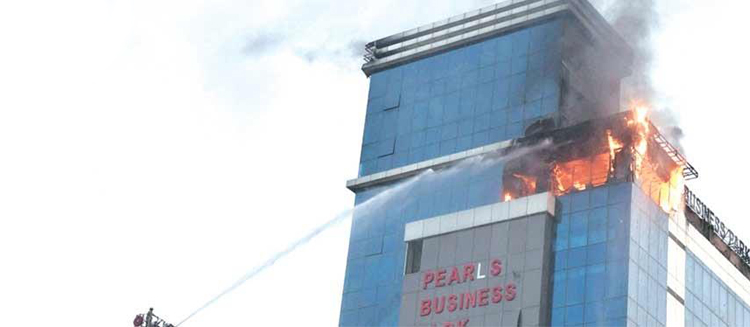Cladding materials play a vital role in modern building design, providing aesthetics, weather protection, and insulation. However, the increasing use of combustible cladding in high-rise buildings has raised serious concerns regarding fire safety. To address these concerns, various countries have established fire classification systems to categorize cladding materials based on their fire performance. When choosing the cladding material for buildings, most people are ignorant about the performance and fire classification of the cladding materials. But in reality, it is highly important to consider these factors in order to prevent any fire accidents. Knowing the fire safety standard of the cladding materials can help in enhancing the safety of your building as well as the residents. In this blog, we will explore the A1, A2, and B fire classifications, their significance, and how they impact building safety.
Post your Requirement
Basically, when the cladding materials for buildings undergo the fire test, they are divided into four major categories. The four categories are:
Combustible Materials
The cladding materials that are highly combustible in nature fall under this category. These materials can easily catch fire, thereby putting the entire building and the life of the residents in danger. On catching fire, the flames can spread at a very fast rate and lead to the release of a large amount of heat. One of the prominent examples of combustible cladding material is wood dust.
Non-Combustible Materials
The non-combustible cladding materials are the ones that do not catch fire at all. Such materials are usually considered to be the safest option for cladding your building. The material does not burn as well as does not produce any flammable vapors. It helps in offering optimum protection to your building in case of any unexpected fire incidents. Common examples of construction cladding materials that fall under this category are terracotta and stone.
Fire-Resistant Materials
These are yet another type of non-flammable materials. When you want to ensure that there is sufficient time for the residents to vacate the building, using fire-resistant cladding materials is an ideal option. Even when your building catches fire, these claddings function optimally and give you enough time to evacuate the place and save your life. Some of the cladding materials coming under this category are brick, gypsum wallboard, and concrete.
Ignition Resistant Materials
The ignition-resistant cladding material catches fire immediately but takes much time for the flame to spread over the entire building. This category stands in between the combustible material and the non-combustible material. Examples of such cladding material are the specific variants of wood.
On the basis of the properties mentioned above, the cladding materials used in the building are classified as A1, A2, and B.
A1 Fire Classification
The highest fire classification is A1. Materials in this category are deemed non-combustible and have excellent fire-resistant properties. A1-rated cladding materials do not contribute to the development or spread of flames, emit smoke, or produce flaming droplets when exposed to fire.
Common A1-rated cladding materials include non-combustible materials like stone, concrete, metal, and certain glass types. These materials are often utilized in critical areas of buildings, especially in high-rise structures, where fire safety is of utmost importance.
Cladding materials in this category exhibit the highest level of fire resistance. They do not contribute to the development or spread of flames and emit minimal smoke and no flaming droplets when exposed to fire. Non-combustible materials are considered the safest and are often used in critical areas of buildings, especially high-rise structures.
A2 Fire Classification
Cladding materials classified as A2 possess a very limited contribution to fire. While they are not entirely non-combustible, they demonstrate excellent fire resistance. A2-rated materials may produce minimal amounts of smoke and flaming droplets when exposed to flames, but their contribution to fire spread is significantly lower compared to combustible materials.
Examples of A2-rated materials include certain metal composite panels, some treated woods, and certain high-density fiberboards. Although not as fire-resistant as A1 materials, A2-rated cladding is still considered relatively safe for use in building applications.
Cladding materials classified as A2 have limited combustibility and demonstrate good fire resistance. While they may produce minimal smoke and flaming droplets when exposed to flames, their contribution to fire spread is significantly lower compared to more combustible materials. A2-rated materials are suitable for use in various buildings.
B Fire Classification
The B fire classification includes materials that have moderate fire performance. Unlike A1 and A2 materials, those classified as B may have a higher propensity to ignite and propagate flames. While B-rated materials are not recommended for high-rise buildings or areas with stringent fire safety requirements, they can still be suitable for low-rise structures and non-critical areas.
Materials in this category have moderate fire performance. They may ignite and propagate flames to some extent when exposed to fire. Cladding materials classified as Class B are generally not recommended for high-rise buildings or areas with strict fire safety regulations. Instead, they may find application in low-rise structures and non-critical areas.
Common B-rated cladding materials include some types of untreated wood, traditional expanded polystyrene (EPS) foam, and certain low-density fiberboards.
Conclusion
Selecting the appropriate cladding materials is crucial for ensuring the fire safety of buildings. The A1, A2, and B fire classifications provide valuable guidance to architects, builders, and regulators in determining the most suitable materials for specific applications.
When constructing high-rise buildings or structures where fire safety is a top priority, A1-rated cladding materials, which are non-combustible, are the preferred choice. A2-rated materials, while not entirely non-combustible, still offer significant fire resistance and are suitable for certain applications. B-rated materials, with moderate fire performance, are best reserved for low-rise buildings and non-critical areas.
By understanding these fire classifications and making informed decisions, we can contribute to safer and more resilient buildings, reducing the risks associated with cladding-related fire incidents.


















Post A Comment